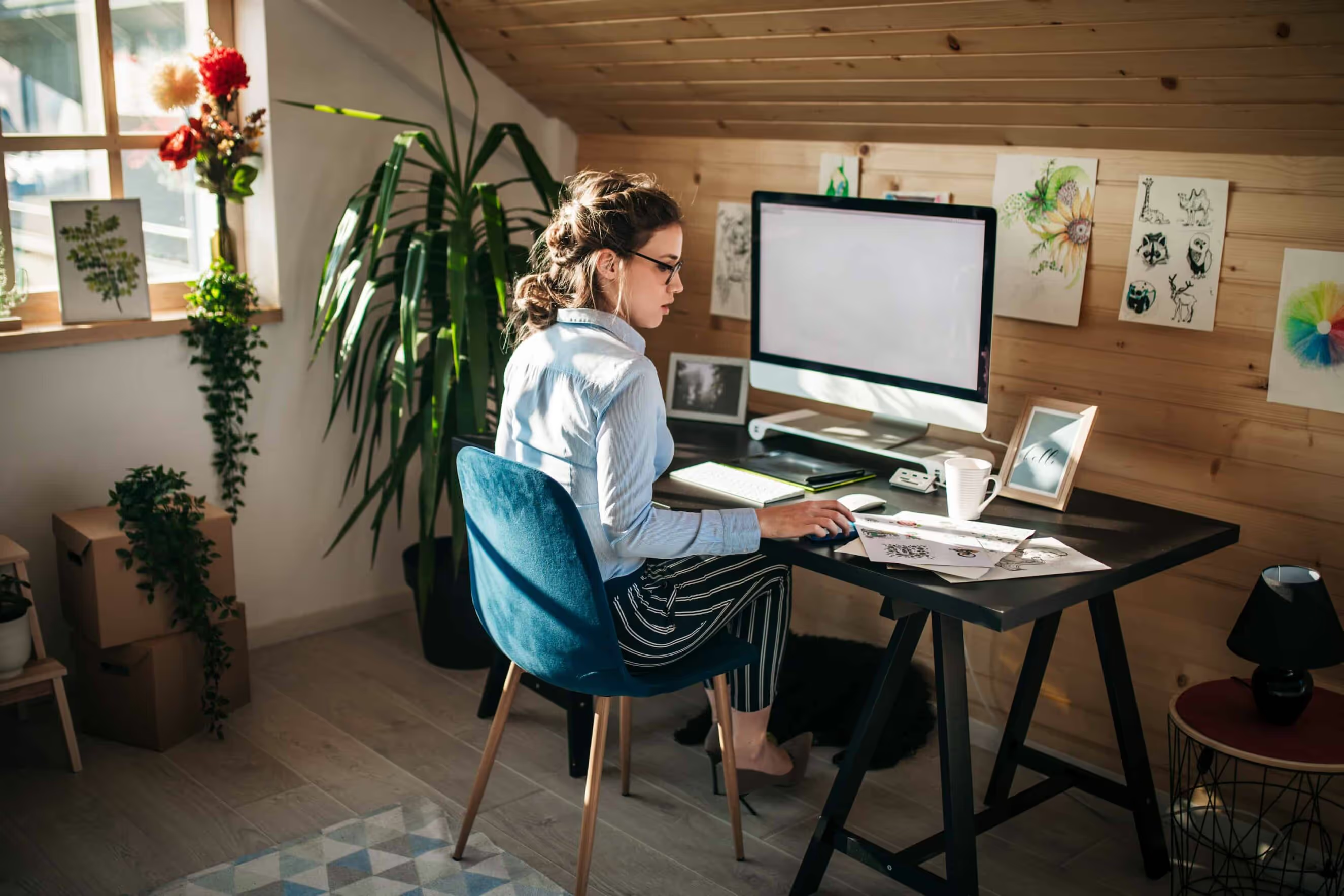There’s no better time for course creators to have their own home recording studio setup. Marketers have already identified video content as essential to gain and retain the fleeting attention span of an internet-based audience. The same strategy holds true for online course creators: Courses that include video are higher value products, sell for more, and create a greater connection between sellers and their audience.
But, don’t be deceived into believing video production has to be complicated and expensive. Fortunately, the latest technology makes audio and video editing easier than ever before. Unless you’re a musician, you don’t need to worry about complicated equipment (such as xlr cables, midi keyboards, and studio monitors). A bedroom recording studio can be created no matter what your budget.
Creators can easily create high quality videos at home using simple equipment—and on a budget. Below, we’re sharing exactly how to create a recording studio at home, our best gear shopping tips, and our top pre- and post-production tips.
How to setup a home video recording studio
Consider this the good news of the day: A professional quality home studio can be made using material that many of us already own. Even if creators want to invest a few dollars here and there to up the production quality, there’s a solid set up at every budget.
DIY an in home recording studio for free to $60
1. Shoot with a phone or laptop
Using a phone or laptop is a free option that can still deliver a high-quality end result. Those unsure where to start should check out this guide to shooting high-quality video with a smartphone. The key thing to remember here is to shoot with the phone horizontal or the laptop upright to create a widescreen video that nobody will be the wiser that it’s shot on an everyday device.
Lastly, those filming on a laptop should make sure the camera is at a 90-degree angle, as tilting the screen can look funny and distorted.
2. Buy a tripod or elevate a laptop setup
For the most flattering shot, a good rule of thumb is to place the camera lens at face level. For those using an iPhone or other smartphone, that may mean using a small tripod like this one comes in at only $26. An even more budget-friendly option for those using a laptop is simply a stack of books or boxes to elevate the laptop camera to face level.
3. Use the right editing tools
We suggest the Filmic Pro app to stabilize an iPhone video. For a laptop, we suggest Screenflow as an affordable way to film and edit content. Our Screenflow tutorial can help explain how to easily create videos. On a PC? Camtasia is a great alternative.
4. Avoid the zoom feature
Zooming in on a phone can make the video blurry. Instead of zooming, move the phone or computer closer to get the same effect without blur.
5. Shoot at 24 frames per second
The average viewer might not catch this, but the trained eye will notice. It’s a simple flip in the settings but makes a more pleasant viewing experience, as that’s what the eyes are used to seeing for movies and TV shows.
6. Use one laptop or phone for video and another phone as a microphone
It may seem a little more complex to have two devices but doing so greatly improves the video sound quality. To try it, set one phone or laptop in front to record visuals but place another off-camera phone closer for a clearer sound. Later on in the editing process, the visuals from one device and the sound from the second can be spliced together.
7. Mark the start of a scene
When syncing up audio to a different visual source, it helps to have a visual cue for where that start syncs. A clapboard with its white stripes and loud noise is a symbol of cinema, but it’s also a waste of money when you have two hands.
Clap loudly at the start of the scene to create a spike of noise that shows up as a tall spike during video editing. Use the height of this point to match the visuals from one camera with the sound on another.
8. Use a sheet as a DIY backdrop
When learning how to DIY a home video studio setup, a background is pretty easy to fake with any large piece of fabric. Remember this insider hack: Black works better than white, which tends to wash out its subject, especially with bright lights.
9. Use soft household objects to stop an echo
A common trouble point is getting an echo. This can come from large rooms, empty apartments, or from clearing furniture out of a room to create a studio setup. Luckily, a very simple solution is to use pillows, rugs, couches, and all things fluffy to absorb sound. It’s as easy as throwing some cushions around the lights. Here’s more on recording high-quality audio for courses.
10. Opt for natural light
Unfortunately, reading lights and other household lamps aren’t ideal for casting even and warm light. And, lighting is something every creator wants to get right. Bad lighting can look sickly or cast unwanted shadows. The best option for cheap lighting? Filming by a window or glass door and using that good old-fashioned natural light. When understanding how to DIY home video studios, remember that lighting is key.

Invest in a high-value studio for $300-900
The upgraded version of the “DIY home video studio” is to create a “high-value” studio. Although the DIY Studio can create beautiful results, it’ll be easier to create high-quality video by investing in a few pieces of equipment.
The high-value studio also has two huge advantages. In the end it’s low cost but yields a high return and it’s semi-permanent. However, knowing where to invest can be a challenge, so we’re breaking it down to know exactly where to put that money.
Home recording studio equipment to invest in
Here are some pro tools that can support your home studio design:
1. A mic
Hanging an iPhone from the ceiling with fishing line might make for a quick microphone fix and good story, but it’s easily trumped by an affordable and higher quality microphone that instantly takes videos to the next level. For less than $150, creators can upgrade to a Blue Yeti. It’s a condenser mic we use and love here at Teachable.

2. Clamp lights
For DIY home video studio lighting, we suggested using natural lighting. But, even natural light isn’t always reliable. For those times, clamp lights are preferable. Add two key lights pointing at the main subject at 45-degree angles and one light aimed at the backdrop to round out the light and get rid of shadows from a moving subject.
Diffusion papers also soften the light to a proper level of brightness. In the case studio lights are the lighting of choice, be sure to shut out natural light as much as possible.
3. A camera
The natural progression from using a smartphone or laptop is to upgrade to a proper camera. There are many options, but a quality and reliable option we found is the Canon SL1. Just remember, when purchasing a camera, tripods are almost always necessary, too.
Before further upgrading gear, consider the following:
- A professional backdrop: A green screen opens up a whole new world of opportunity. However, a classic grey or white backdrop also looks professional.
- Sound panels: Buying and installing a few sound panels to muffle extraneous noise might be a good option for those wishing for higher sound quality.
- A nicer camera: Because “Lord of the Rings” wasn’t shot on an iPhone.

Video pre-production tips
We’re sharing some of our best tips for video production:
Do research
Strong creators know it’s always ideal to do competitive research. Focus on the technical side of competitors’ videos: What angles are they using? How are they editing clips together? Do they use slides? Analyzing other’s teaching methods can help creators design a teaching method of their own.
Think about framing
It might feel natural to sit smack-dab in the center of a video, but it may not actually be the best option. For those showing products or adding text overlays to their videos, it might make more sense to sit off to a side.
Beyond frame positioning, avoid sitting too close to the camera. We’ve all seen those videos that make you feel like you’re nose to nose with the person on the other side of the screen. There are other ways to get up close and personal with students, trust us.
Blur the background
Increasing the distance between the subject and background can help achieve this. When the camera focuses on the subject’s face, it will focus less on things farther away. Another option is to adjust the camera’s lens. Changing the aperture changes how much of a scene the camera catches. The lower the aperture number, the smaller part of the scene that’s in focus.
We won’t go into a full photography tutorial right now but just remember this bit of wisdom: Want a blurry background? Add distance and shoot in a lower aperture.
Practice
It’s going to feel awkward at first, but the one way to make it less awkward is simply to practice—and then practice some more. Rehearse the video’s script to sound more natural and less forced. (Get our full rundown of how to feel more comfortable on camera this way.)
Post-production tips
We have a few tricks up our sleeve here at Teachable to make the video editing process smooth as butter.
Record room tone
Capture around 30 seconds of “room tone” or the base sound of the room. Turn on the mic and let it record. This sound will be used in the editing process to fill audio gaps, eliminate white noise, and smooth out transitions from one scene to the next. It’s quicker than trying to edit out every time gap or inserting filler noise.
Give enough lead-time between takes
This is especially important with screencasts. It’s fine to stop and keep going if a mistake is made during the filming process as long as there’s ample lead-time left. Cut out fumbles and filler time and use room tone to smooth the transition.
Editing out a fumble:

Ease transitions with cross-fading
If there’s a transition in a video that doesn’t need room tone but rather a little smooth-over, use crossfading. A majority of non-linear video editing programs do this in one of two ways:
- Drag the beginning/end of one clip over the end/beginning of another
- Line up the two clips next to each other and then apply a cross dissolve/fade.
Save content on an external hard drive
Big screens aren’t the only thing big about videos, they’re massive files too. Some programs, including Screenflow, capture the whole project as one file (in this case a .screenflow file). Other programs create a series of source files, project files, and even rendering files. All are massive. Enter an external hard drive to make this a little easier.
When buying a great external hard drive, it might be a good idea to look for quality. Working with video, opt for at least 500GB of space, but we prefer 1TB+.
Also, check out transfer rates a.k.a. how long it takes to stream data to and from the computer. For creators saving and transporting big files, it’s important to know that a 1.8GB movie transferring at .05MB/sec will take hours but at 25MB/sec only a few minutes.
Compress videos after exporting them in HD
The better the video resolution, the bigger the file, and thus the better the connection needs to be in order to watch, stream, or download the video in a reasonable amount of time.
We can’t control the internet speeds of our viewers, but we can do our best with what we can control. Export videos in the highest quality possible, then compress them.
By implementing these DIY home video recording setup and tips, creators can create high quality content from at home and on a budget.
FAQs
What do I need to set up a recording studio at home?
You can create a home studio with many items you may already own, such as a phone or laptop. You can get creative with books to prop up your camera, in lieu of purchasing a tripod. You will also want some video and/or audio editing apps, good lighting, a clean backdrop (consider using a sheet), and other household items. If you’re ready to invest, a mic, lighting, and a professional camera are essential pieces of home studio equipment to consider.
How much will it cost to build a home studio?
Creators can easily create high quality videos at home using simple equipment—and on a budget. A professional quality home studio can be made using material that many of us already own. Even if creators want to invest a few dollars here and there to up the production quality, there’s a solid set up at every budget. Whether you’re ready to invest $300 to $900 or can only afford under $60, this article will covers everything you need to get started.
Sections of this post are adapted from previous content written by Ashley Hockney and Morgan Timm.
Join more than 150,000 creators who use Teachable to make a real impact and earn a real income.








